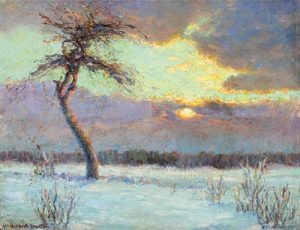
William Herbert “Buck” Dunton was born in Augusta, Maine in 1878. A founding member of the Taos Society of Artists, he is largely known for landscape and genre scene paintings set in the American Southwest. As a child, Dunton worked as a ranch hand and regularly traveled on nature expeditions with his grandfather before enrolling at the Cowles Art School in Boston. This experience as a youth informed his artistic practice years later, as he often recalled the imagery of rural Maine. After completing his artistic training, he worked in New York City as an illustrator, contributing to high-profile publications such as Harper’s Weekly, Collier’s and Scribner’s. In New York, he simultaneously took classes at the Art Students League, where he became acquainted with painter Ernest Blumenschein. Blumenschein had been traveling to the Southwest for years and encouraged him to explore the region. While in New York, Dunton also experimented with lithograph printing during periods of financial instability since the medium was less expensive to work in.
Dunton first visited Taos, New Mexico in 1912 and became part of the Taos art colony, although he had traveled to Montana in 1896, when searching for subject matter as part of a magazine commission. He worked regularly as an illustrator for over a decade, eventually leaving the industry out of frustration with the pressure of constant deadlines. Dunton’s move to New Mexico allowed him to focus on capturing the disappearing scenes of the American Southwest, as the region experienced industrialization. His involvement with the Taos Society of Artists included organizing traveling collective exhibitions, which increased the national popularity of the movement, and brought further acclaim to the Taos art colony. His paintings of atmospheric scenes and majestic landscapes earned him the reputation of leading Southwest painter during the first half of the twentieth century. In 1922, he left the group and begin regularly presenting his work in solo exhibitions. Between 1928 and 1935, Dunton’s health rapidly declined, and he eventually was diagnosed with cancer, which he died from in Taos at the age of 57.
With recent renewed interest in his work, the exhibition “William Herbert “Buck” Dunton: A Mainer Goes West” was organized by the Phoenix Art Museum in 2023. His paintings are collected by institutions such as the Smithsonian American Art Museum, Phoenix Art Museum, and Brigham Young University’s Museum of Art, among others. The Stark Museum in Orange, Texas houses the largest collection of Dunton’s work.